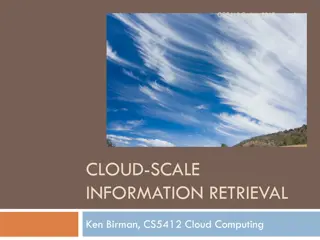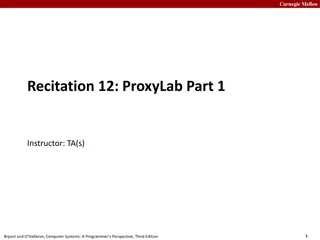Proxies and Caching in Web Infrastructure
Proxies act as intermediaries between user agents and origin servers, forwarding requests and responses. They are used for filtering, caching, content routing, access control, and more. HTTP requests sent via proxies include Via: headers, and HTTPS traffic can be tunneled using the CONNECT method for end-to-end encryption. Proxy autoconfiguration files and caching strategies are essential components in optimizing web infrastructure for efficient data retrieval.
Download Presentation

Please find below an Image/Link to download the presentation.
The content on the website is provided AS IS for your information and personal use only. It may not be sold, licensed, or shared on other websites without obtaining consent from the author.If you encounter any issues during the download, it is possible that the publisher has removed the file from their server.
You are allowed to download the files provided on this website for personal or commercial use, subject to the condition that they are used lawfully. All files are the property of their respective owners.
The content on the website is provided AS IS for your information and personal use only. It may not be sold, licensed, or shared on other websites without obtaining consent from the author.
E N D
Presentation Transcript
Proxies and Caching COMP3220 Web Infrastructure Dr Nicholas Gibbins nmg@ecs.soton.ac.uk
Proxies Intermediary that acts as server and client Receives request from user agent and forwards to origin server Returns response to user agent Can be chained in sequence User Agent Origin Server Proxy Multiple uses: Filtering Caching Content routing Anonymising Access control Transcoding Fielding, R. and Reschke, J. (2014) Hypertext Transfer Protocol (HTTP/1.1): Message Syntax and Routing. RFC7230. Available at: https://tools.ietf.org/html/rfc7230 3
Proxies and HTTP When sending requests via a proxy, user agent replaces the path in the request line with the full URI Proxies add Via: headers to all messages they send HTTP version, hostname of proxy Append to existing header if chaining proxies URI to be proxied GET http://example.org/ HTTP/1.1 Host: example.org 4
GET http://example.org/ HTTP/1.1 Host: example.org GET / HTTP/1.1 Host: example.org Via: HTTP/1.1 proxy.net HTTP/1.1 200 OK ... HTTP/1.1 200 OK Via: HTTP/1.1 proxy.net ... 5
Tunnels But what about HTTPS? TLS guarantees end-to-end encryption of both message body and headers Proxies can't understand the request CONNECT method establishes a tunnel to the destination origin server Proxy will forward all subsequent packets in both directions CONNECT example.org:443 HTTP/1.1 Host: example.org:443 6
Proxy Autoconfiguration proxy.pac file containing sandboxed JavaScript defining FindProxyForURL() Configured in browser (specify URI of proxy.pac) Configured via DHCP (option 252, containing URI of proxy.pac) Configured via DNS (looks for host named wpad, requests wpad.dat) Note: common practice, not a (formal) standard function FindProxyForURL(url, host) { // ... } Return values: DIRECT PROXY host:port 7
Caching Recall the following REST constraint: response data must be labelled as cacheable or non-cacheable User Agent Origin Server Proxy In practice, both user agents and proxies may cache representations User agent private cache Proxy shared cache How do we know what to cache? How do we avoid stale data? Cache Cache 8 Fielding, R. et al (2014) Hypertext Transfer Protocol (HTTP/1.1): Caching. RFC7234. Available at: https://tools.ietf.org/html/rfc7234
Key concepts Freshness/staleness How long is it since the representation was generated by the origin server? Is there a lifetime (or expiration time) associated with the representation? Revalidation If a cache contains a stale representation, we need to refresh it by either: 1. Checking that it is still the same as the representation served by the origin server, or 2. Fetching a new (fresh) representation with which to replace it 9
Cache headers Age: seconds Sent by a proxy server to indicate how long ago a representation was generated by the origin server Expires: timestamp Indicates when a representation should be considered stale Cache-Control: directive, directive, ... Specifies caching behaviour, may be sent by user agents, proxies and origin servers 10
Request Cache-Control: directives no-cache Client will not accept cached representations that have not been validated no-store No part of this request or response may be cached max-age=seconds Client will not accept cached representations more than seconds old max-stale=seconds Client will accept cached representations that are up to seconds past their freshness min-fresh=seconds Client will accept cached representations that will remain fresh for at least seconds no-transform Intermediary must not transform the representation (note: orthogonal to caching) 11
Response Cache-Control: directives no-cache Representations may not be reused without being revalidated no-store No part of this request or response may be cached must-revalidate Stale representations may not be reused without being revalidated max-age=seconds Representation is to be considered stale after seconds public Representation may be stored in a shared cache and used for other users private Representation may not be used for other users 12
GET http://example.org/ HTTP/1.1 Host: example.org GET / HTTP/1.1 Host: example.org HTTP/1.1 200 OK Cache-Control: max-age=600 ETag: "39d5-5943f8fdc2607" HTTP/1.1 200 OK Cache-Control: max-age=600 Age: 0 ETag: "39d5-5943f8fdc2607" http://example.org/ max-age=600, age=0, etag=39d5-5943f8fdc2607 13
GET http://example.org/ HTTP/1.1 Host: example.org HTTP/1.1 200 OK Cache-Control: max-age=600 ETag: "39d5-5943f8fdc2607" Age: 120 http://example.org/ max-age=600, age=120, etag=39d5-5943f8fdc2607 14
GET http://example.org/ HTTP/1.1 Host: example.org http://example.org/ max-age=600, age=720, etag=39d5-5943f8fdc2607 GET / HTTP/1.1 Host: example.org If-None-Match: "39d5-5943f8fdc2607" HTTP/1.1 200 OK Cache-Control: max-age=600 ETag: "4b4f-77a6c3ab117a2" HTTP/1.1 200 OK Cache-Control: max-age=600 Age: 0 ETag: "4b4f-77a6c3ab117a2" http://example.org/ max-age=600, age=0, etag=4b4f-77a6c3ab117a2 15
GET http://example.org/ HTTP/1.1 Host: example.org http://example.org/ max-age=600, age=720, etag=39d5-5943f8fdc2607 GET / HTTP/1.1 Host: example.org If-None-Match: "39d5-5943f8fdc2607" HTTP/1.1 304 Not Modified Cache-Control: max-age=600 ETag: "39d5-5943f8fdc2607" HTTP/1.1 200 OK Cache-Control: max-age=600 Age: 0 ETag: "39d5-5943f8fdc2607" http://example.org/ max-age=600, age=0, etag=39d5-5943f8fdc2607 16
Representation Caching and content negotiation Metadata: Content-Type: video/mp4 We're caching representations, but there may be multiple representations of a given resource Data: Resource How do when distinguish between the different cached representations of a resource? today s BBC weather forecast for Southampton Representation Metadata: Content-Type: text/html Data: <html> <head> <title>BBC Weather Southampton</title> ... </html> Cached representations record the values of the headers listed in the Vary: header 17
GET http://example.org/ HTTP/1.1 Host: example.org Accept: text/html GET / HTTP/1.1 Host: example.org Accept: text/html HTTP/1.1 200 OK Location: http://example.org/ Content-Type: text/html Vary: accept, accept-language HTTP/1.1 200 OK Content-Type: text/html Vary: accept, accept-language http://example.org/ max-age=600, age=0, text/html 18
GET http://example.org/ HTTP/1.1 Host: example.org Accept: text/plain GET / HTTP/1.1 Host: example.org Accept: text/plain http://example.org/ max-age=600, age=120, text/html HTTP/1.1 200 OK Content-Type: text/plain Vary: accept, accept-language http://example.org/ max-age=600, age=120, text/html max-age=600, age=0, text/plain HTTP/1.1 200 OK Content-Type: text/plain Vary: accept, accept-language 19
Further reading Fielding, R. and Reschke, J. (2014) Hypertext Transfer Protocol (HTTP/1.1): Message Syntax and Routing. RFC7230. https://tools.ietf.org/html/rfc7230 Fielding, R. et al (2014) Hypertext Transfer Protocol (HTTP/1.1): Caching. RFC7234. https://tools.ietf.org/html/rfc7234 20
Next lecture: Authentication and Authorisation























